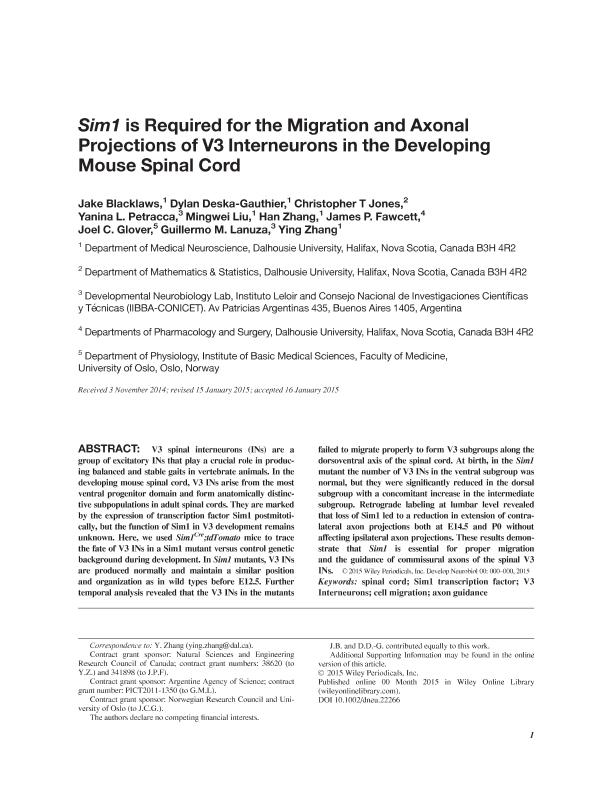Artículo
Sim1 is required for the migration and axonal projections of V3 interneurons in the developing mouse spinal cord
Blacklaws, Jake; Deska Gauthier, Dylan; Jones, Christopher T.; Petracca, Yanina Luján ; Liu, Mingwei; Zhang, Han; Fawcett, James P.; Glover, Joel C.; Lanuza, Guillermo Marcos
; Liu, Mingwei; Zhang, Han; Fawcett, James P.; Glover, Joel C.; Lanuza, Guillermo Marcos ; Zhang, Ying
; Zhang, Ying
 ; Liu, Mingwei; Zhang, Han; Fawcett, James P.; Glover, Joel C.; Lanuza, Guillermo Marcos
; Liu, Mingwei; Zhang, Han; Fawcett, James P.; Glover, Joel C.; Lanuza, Guillermo Marcos ; Zhang, Ying
; Zhang, Ying
Fecha de publicación:
02/2015
Editorial:
Wiley
Revista:
Developmental Neurobiology
ISSN:
1932-8451
e-ISSN:
1932-846X
Idioma:
Inglés
Tipo de recurso:
Artículo publicado
Clasificación temática:
Resumen
V3 spinal interneurons (INs) are a group of excitatory INs that play a crucial role in producing balanced and stable gaits in vertebrate animals. In the developing mouse spinal cord, V3 INs arise from the most ventral progenitor domain and form anatomically distinctive subpopulations in adult spinal cords. They are marked by the expression of transcription factor Sim1 postmitotically, but the function of Sim1 in V3 development remains unknown. Here, we used Sim1(Cre) ;tdTomato mice to trace the fate of V3 INs in a Sim1 mutant versus control genetic background during development. In Sim1 mutants, V3 INs are produced normally and maintain a similar position and organization as in wild types before E12.5. Further temporal analysis revealed that the V3 INs in the mutants failed to migrate properly to form V3 subgroups along the dorsoventral axis of the spinal cord. At birth, in the Sim1 mutant the number of V3 INs in the ventral subgroup was normal, but they were significantly reduced in the dorsal subgroup with a concomitant increase in the intermediate subgroup. Retrograde labeling at lumbar level revealed that loss of Sim1 led to a reduction in extension of contralateral axon projections both at E14.5 and P0 without affecting ipsilateral axon projections. These results demonstrate that Sim1 is essential for proper migration and the guidance of commissural axons of the spinal V3 INs.
Palabras clave:
Spinal Cord
,
Axonal Projection
,
Migration
Archivos asociados
Licencia
Identificadores
Colecciones
Articulos(IIBBA)
Articulos de INST.DE INVEST.BIOQUIMICAS DE BS.AS(I)
Articulos de INST.DE INVEST.BIOQUIMICAS DE BS.AS(I)
Citación
Blacklaws, Jake; Deska Gauthier, Dylan; Jones, Christopher T.; Petracca, Yanina Luján; Liu, Mingwei; et al.; Sim1 is required for the migration and axonal projections of V3 interneurons in the developing mouse spinal cord; Wiley; Developmental Neurobiology; 75; 9; 2-2015; 1003-1017
Compartir
Altmétricas



